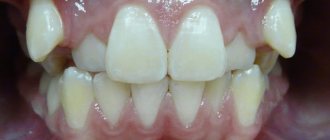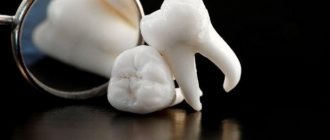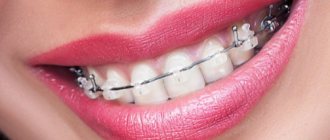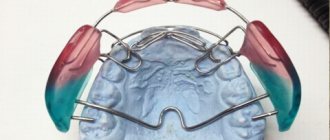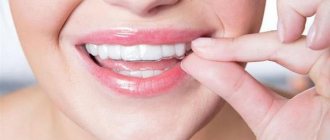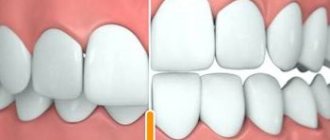Problem: a woman came to Family Dental on the advice of friends - she was looking for a clinic where she could restore two missing teeth in her upper jaw. During the diagnosis, the congenital absence of several teeth (primary adentia) and the long-term absence of one of the upper teeth due to extraction (secondary adentia) were discovered. The absence of teeth caused displacement of neighboring teeth and malocclusion.
Solution: the bite was corrected using Damon braces (the normal closure of the upper and lower teeth was restored), a place was prepared for prosthetics of the two upper teeth, 2 Astra Tech dental implants were installed, 13 teeth were replaced with ceramic crowns (E.max ceramics and zirconium dioxide).
Consultation, diagnosis and development of a comprehensive treatment plan
The woman had her central front tooth removed in another clinic because the tooth had decayed. At that time, she was not ready to install a dental implant, so the tooth was covered with a suspended structure to restore minimal aesthetics:
On the upper left there is no one more tooth (long ago removed due to destruction), and there is a gap between the teeth.
After some time, the woman began to look for a clinic where she could have two teeth restored with implants so that it would be beautiful. On the advice of friends, she turned to the Family Dentistry to orthopedic dentist A.S. Ivankov.
At the consultation, it turned out that, apart from the two removed teeth, there were no fifth teeth from birth (primary adentia), that is, there were milk teeth, but the permanent teeth did not grow during the change of teeth. Since this was a long time ago, the remaining teeth have shifted, and the missing teeth have closed almost completely. Due to the displacement of the teeth, the bite is disturbed, and in some places the upper teeth overlap the lower teeth (crossbite). An incorrect bite causes overload of certain groups of teeth, so there are areas of receding gums (gingival recession) in the area of the lower front teeth.
The orthopedic dentist advised us to start preparing for prosthetics by correcting the bite. Once the correct closure of the teeth has been restored and the place for prosthetic replacement of the two upper teeth has been prepared, it will be possible to install dental implants and crowns on implants. In a correct bite there will be no overload zones, implants and crowns will last longer.
The patient consulted orthodontist M.P. Sleptsova, calculations were made using dental casts and x-rays (panoramic, TRG in lateral projection). The patient also visited an osteopath, who at Dial-Dent always takes part in the diagnosis and treatment of orthodontic patients, since all changes in the position of the teeth affect posture, the functioning of the muscles and joints of the head and neck, and the functioning of the body as a whole.
The treatment plan was drawn up at a joint consultation of an orthopedic dentist and an orthodontist - the main specialists in this treatment. The patient’s desire was this: to make it beautiful and functional, but there is no need for perfect aesthetics, it’s better to have fewer interventions. Since the 5th teeth are missing evenly in all segments, and the gaps from them are almost completely closed, it was decided not to expand the teeth in these places, but, on the contrary, to move them, finally closing the gaps between the teeth, and create even dentition. The chewing teeth are worn down and destroyed by caries, the bite needs to be made higher, so after treatment with braces, the missing height of the teeth will be restored by dental crowns.
Treatment plan:
- Hygienic preparation for complex treatment.
- Re-treatment of the canals of one upper chewing tooth with a microscope, replacement of the old pin in the tooth with a new one made of fiberglass (since there will be a ceramic crown), treatment of dental caries.
- Orthodontic treatment – expansion of the upper dentition and restoration of normal closure of the teeth, preparation of a site for the installation of 2 dental implants in the area of the central and fourth tooth on the upper jaw on the left with displacement of the canine to the center, closing the gaps between the teeth on the lower jaw.
- Osteopathic correction throughout the entire orthodontic treatment.
- Installation of two Astra Tech dental implants.
- Dental prosthetics with ceramics (on implants and three front upper teeth with ceramic crowns made of E.max ceramics, and on chewing teeth with crowns made of zirconium dioxide).
The issue of eliminating gum recession (transplanting soft tissues into the recession zone) remained outside the treatment plan for now, since the patient did not want to increase the scope of surgery. It was decided to monitor the gums after orthodontic treatment, since in this case the cause of recession is precisely the overload of groups of teeth due to malocclusion, and after eliminating the overload, the recession can stabilize.
The estimate for treatment described in detail all the stages, their sequence, duration, and the cost of treatment at each stage (payment in stages). Treatment according to a pre-compiled estimate is much more convenient for the patient - there are no unexpected unpleasant surprises, the final amount of expenses and the time required for treatment are clear.
Commentary by the chief physician of Dial-Dent, orthopedic dentist S.V. Tsukora: “Some try to save money by carrying out different stages of treatment in different clinics (one has a familiar therapist, and another offers a special offer to brush your teeth). With this approach, there is no guarantee for the entire treatment; you often have to redo someone else’s work because it is not consistent with the final result.
The right approach in difficult cases is to look for a clinic where a team of doctors works and the treatment is carried out thoughtfully, step by step! After completion of treatment, the clinic will be able to provide a guarantee for all work performed. The patient must also follow preventive measures after treatment - come for examination, have professional teeth cleaning. If all this is done in one clinic, then there will be no problems for many years.”
Is it possible to put braces on crowns?
Installation of orthodontic brackets on an artificial crown is also possible. Treatment of malocclusion occurs thanks to living roots under the prosthesis, capable of moving in the direction specified by the brace system.
But most likely you will have to give up wearing inconspicuous lingual or aesthetic ceramic models, opting for a metal structure. This is due to the better adhesion of a metal lock to the surface of an artificial crown in comparison with retention elements made of other materials.
You will also have to carefully care for the oral cavity until the correct bite is formed, protecting the braces from mechanical stress. It is worth giving up hard, sticky foods, taking care to maintain a reliable fixation of the system.
Attaching a bridge prosthesis to supporting teeth is also not a problem. The orthodontist may recommend temporarily removing the bridge and installing temporary crowns, or suggest sawing the prosthesis into several parts to protect it from destruction.
Correction of bite – treatment with braces
Treatment with braces lasted 2 years. Damon self-ligating braces were used for treatment. Ceramic braces were installed on the front teeth, which created greater comfort for the patient, since they are hardly noticeable on the teeth.
Due to crossbite in some areas, overbites were placed on the lower teeth at the beginning of treatment.
After achieving proper closure of the teeth, the onlays are removed without leaving any traces.
The patient visited the orthodontist every 1.5 months.
Osteopathic correction was carried out after almost every visit to the orthodontist. The osteopath relieves accumulated tension in the bones of the skull and masticatory muscles, which facilitates the movement of teeth and reduces pain after installing new equipment or replacing arches. Treatment by an osteopath helps stabilize the result of bite correction.
As a result of orthodontic treatment, the dentition is aligned and space is created for prosthetics of the two upper teeth.
To temporarily restore the aesthetics of a smile, the missing central tooth is hidden using a hinged structure.
Braces for missing teeth
A good specialist can develop an orthodontic treatment plan even in this situation - of course, if there are still supporting teeth in the oral cavity on which the braces can be attached. Otherwise, dental implantation will first need to be done while you sleep or under general anesthesia. True, the amount of possible orthodontic care in this case may not correspond to the patient’s wishes. For example, a doctor can correct the position of the front incisors, but will most likely refuse to eliminate the “gap” at the site of the extracted tooth. Such a complex procedure will take a lot of time and require significant effort, and its result, for objective reasons, may be unpredictable.
Installation of dental implants
Two Astra Tech dental implants (Sweden) were installed. These are reliable implants that have been installed at Dial-Dent for more than 15 years. Astra Tech implants perfectly into bones due to the quality, as well as modern materials and technologies used in their manufacture.
After 4 months it was possible to begin dental prosthetics.
Indications for partial correction
Malocclusion has a number of negative consequences, but the reason patients turn to an orthodontist in most cases is the unaesthetic appearance of their teeth and smile. In addition to aesthetics, malocclusion pathologies lead to speech defects, frequent dental diseases and gastrointestinal problems. Treatment is recommended in adolescence, but the defect can be corrected in adult patients.
Indications for installing braces on the upper jaw:
- curvature of several teeth, which does not lead to deviation in the closure of two jaws;
- deviation in the location of the dentition of individual teeth;
- the growth of one (several) teeth outside the dentition (in this case, the units are not superfluous);
- trema and diastema no more than 3 mm;
- slight degree of twisting of individual units;
- re-correction for mild forms of pathology.
In rare cases, experts recommend fixing the system on only one jaw, since in the future consequences may arise that require repeated, but complex, correction.
Dental prosthetics with ceramics
After correcting the bite, the gum recession stopped, as the overload of the teeth was eliminated, the patient did not complain about tooth sensitivity, and did not want to have another operation for the sake of aesthetics, so a soft tissue transplant was not performed and the gum level was not changed. This is decided before dental prosthetics, since the shape of the dental crowns depends on the level of the gums.
At the first stage of prosthetics, wax modeling was performed - models of dental crowns were made from wax so that the patient could evaluate the type of restorations before preparing the teeth.
Temporary dental crowns are then made from the wax models. Temporary dentures help the patient get used to the new sensations of teeth closing and appearance. You can make adjustments at this stage to make permanent crowns more perfect. In addition, temporary crowns are needed so that the gums take the desired shape in the area of the implants, since there have been no teeth there for a long time, and the gums become smooth, but should look like an arch.
A few weeks later, when the gums had returned to normal shape, impressions were taken for permanent ceramic crowns.
Dental crowns were made in Dial-Dent’s own dental laboratory (teeth with crowns are marked on jaw models):
Prosthetics of the front teeth requires excellent aesthetics, so crowns for all front teeth are made of E.max ceramics (including implants). E.max ceramics make it possible to make very thin restorations characterized by the natural translucency of the enamel. To make teeth on implants look natural, the abutment (the base for the crown installed on the implant) is also made of ceramic. For chewing teeth, strength is more important, so the crowns for the chewing group are made of zirconium dioxide.
Braces and implantation
Do they put braces on implants? An orthodontic system cannot be installed directly onto an implant. Natural tooth roots have little mobility, which is ensured by the presence of a ligamentous apparatus. Their gradual displacement with the help of braces does not harm the body.
An implant is a fixed artificial root implanted in place of a removed unit. Mechanical displacement of the implant will lead to injury and inflammation of the surrounding tissues, as well as to its rejection and loss from the bone. Therefore, it is better to carry out implantation after removing the device that corrects the bite.
If there is an implant, and if the position of the teeth is slightly crooked, it is recommended to install veneers or use crowns to restore the smile.
Dial-Dent specialists who restored the beauty of your smile
- Orthopedic dentist A.S. Ivankov - treatment planning, coordination of specialists’ work, dental prosthetics with ceramic crowns.
- Orthodontist M.P. Sleptsova - treatment with braces, preparation for dental prosthetics.
- Implant surgeon V.P. Alaverdov – installation of dental implants.
- Osteopathic doctor V.V. Bystrov – osteopathic correction during the period of occlusion correction.
- Dentist-therapist – treatment of dental caries, root canal treatment with a microscope.
- Dental hygienist E. Smirnova – professional dental hygiene.
- Dental technician D.V. Wolf – making dental crowns from ceramics.
- Dental assistants – S. Shchelkova, A. Antoshkina, M. Erkimbekova.
See other examples of the work of Dial-Dent specialists here.
Make an appointment for a consultation by phone +7-499-110-18-04 or through the form on the website. You can ask questions about dental prosthetics to the chief doctor of the clinic, Sergei Vladimirovich Tsukor, at
Braces and implantation. Wearing braces and implants together – is it possible or not?
Content:
- Installing an implant while wearing braces
- Braces and implantation
- Is it possible to put braces after implantation?
Many patients in dental clinics require not only bite correction, but also restoration of lost teeth. Therefore, a natural question often arises: “Is it possible to install an implant during braces?” Orthodontics and implantation are combined techniques, but each clinical case is individual. Let's look at how to properly combine these two technologies.
Contraindications
Installation of braces, regardless of the place of their attachment, is carried out only in the absence of concomitant dental diseases (pulpitis, caries, periodontal disease, etc.). Before the correction begins, the patient undergoes treatment and professional cleaning. These indications are relative limitations that can be eliminated before the main occlusion therapy is carried out.
Absolute contraindications to installing braces only on the upper dentition:
- severe form of bite pathology;
- deviation in the closure of the jaws or individual teeth (molars or canines);
- severe curvature of teeth;
- torsion with a distance between units greater than 1 mm;
- The gap between two adjacent teeth is more than 3 mm.
It is not recommended to put braces on people with mental illness, immunodeficiency, endocrine and cardiovascular systems, or oncology. In case of contraindications, A-Medic clinic specialists select another method for eliminating malocclusions.
Features of bite correction with implants
The main obstacle to orthodontic treatment after implantation is that artificial roots form an integral whole with the bone and cannot move in it. Living teeth are held in their sockets by ligaments. Therefore, their positions are not rigid and movement is possible at any age. The length of such “steps” is hundredths of a millimeter, but gradually you can move the tooth to any position. However, if there is a stationary implant in its way, the task becomes almost impossible. In this case, it is often necessary to remove the titanium rod, which interferes with orthodontic treatment, and install it back after or during the process of bite correction.
Of course, another way out can be found in this case. For example, polish the enamel of dental units or reduce the size of a molar, turning it into a premolar. Such decisions are made by the dentist together with the patient. In this case, all individual features of the clinical picture are taken into account.
If the implant does not prevent the movement of tooth roots, but the crown installed on it violates the aesthetics of the aligned row, the problem is solved by an orthopedic surgeon. For example, you can replace a straight abutment with an inclined one and thus correct the vertical position of the crown.
FREE COMPUTED TOMOGRAPHY AND ORTHODONT CONSULTATION
Kuznetsov Egor Andreevich
Dentist-orthodontist, member of the European Association of Orthodontists. Certified specialist in working with all types of braces and clear aligners.
Work experience - 13 years.
At the first consultation, you will be able to undergo a dental computed tomography scan, find out how long the treatment will take and what results await you. Together with an orthodontist, you will select the best option for a brace system, receive recommendations for correcting your bite and answers to all your questions.
Types of bracket systems
Today the following systems of four types of materials are used:
- Metal. The most common and affordable, and also the most durable. But there are also nuances: if we talk about aesthetics, then metal braces are not the most advantageous option, and some people are allergic to the presence of metal in the mouth.
- Plastic. This type of braces is also quite inexpensive, but they are less durable than stainless steel. An important nuance - plastic structures are quickly stained by coffee, tea, cigarettes, acquiring a yellowish tint. It is better not to choose them for lovers of these drinks or smokers.
- Ceramic. Such designs are selected exactly to match the color of the enamel, so they look aesthetically pleasing and do not spoil the smile, and the ceramics are very durable. But one of the disadvantages of ceramic braces is their high cost.
- Sapphire. They are made from artificially grown sapphire crystals and are recognized as the most beautiful. Single crystals are transparent and invisible on the teeth; moreover, they can be easily cut and given any desired shape. But this type of structure is also quite expensive.
- Lingual braces can be made from any of the listed materials. This is the name of the system that is attached to the inside of the teeth and is invisible to the eyes of others. Such braces are often used when installed on the front incisors while maintaining the aesthetics of the dentition.
Most often, metal dental braces are chosen for correction due to their reasonable cost and practicality. However, in some cases, for example, with the same allergies, it is necessary to consider another type of orthodontic structures.
Useful tips about dental implantation from an orthodontist
The most important recommendation to patients is to try to preserve their teeth for as long as possible. Don’t rush to remove them, strive to treat them, even if their lifespan after that is five to seven years. Your own teeth are always better than the highest quality and most beautiful crowns and implants.
If dental implants are being considered, it is helpful to review the following recommendations from your orthodontist:
- Do not delay installing an artificial root if necessary. Timely restoration of the integrity of the row will prevent loss of bone tissue in the area of the formed defect and stop the movement of neighboring units to the empty space.
- Listen to your specialist if he recommends not installing an implant in favor of moving the remaining molars. The orthodontist may suggest, for example, to move the “eight” to the place of the seventh unit, and it, in turn, should be directed towards the removed “six”. This technique is not used often, but sometimes it makes sense.
- Make sure that implantation and orthodontic treatment are carried out by the same team of specialists.
It is very important that the orthodontist and surgeon communicate with each other. We jointly developed a competent, well-thought-out treatment plan and followed it. This can only be done if implants and braces are installed in the same clinic, with preliminary treatment planning in which all specialists participate.

